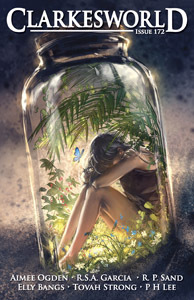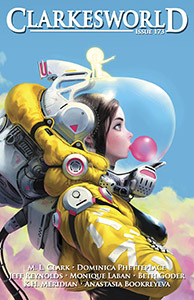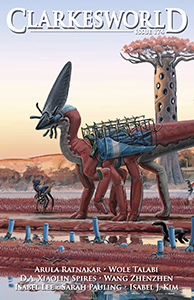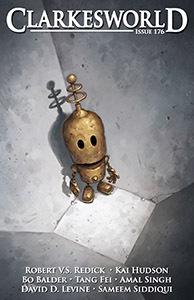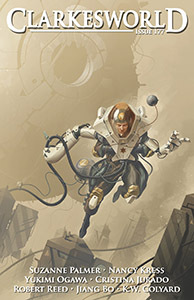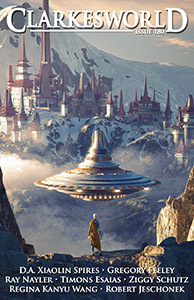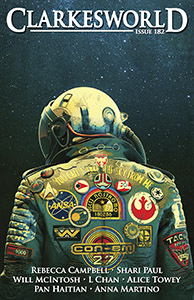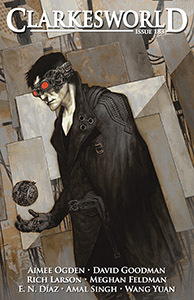Neil Clarke's Blog, page 5
April 9, 2022
For the tenth time
The Hugo Award finalists were announced this week and I’m honored to once again be a finalist for Editor Short Form. This is my tenth time in the category. Currently 0-9. Maybe the tenth time is the charm. I’d like to thank everyone who nominated and congratulate my fellow finalists.
I’d also like to give a shout out to Novelette finalist Suzanne Palmer. So happy to see “Bots of the Lost Arc” in the running. This is a sequel story to “The Secret Life of Bots” which won the 2018 Hugo Award for Best Novelette.
January 24, 2022
Clarkesworld Reader’s Poll – Round One
The nomination phase for our 2021 Reader’s Poll kicks off today! Celebrate your favorite 2021 Clarkesworld cover art and stories by giving them a nod. The top five go onto the final round in February. Ends 1/26/22 11AM EST.
www.surveymonkey.com/r/cw2022nom
Stories and art here:
neil-clarke.com/2021-clarkesworld-stories-and-cover-art/
“But I haven’t read all the stories!”
No no no… don’t worry about that. This is about showing some love for the stories you read and enjoyed. You don’t need to read everything to do that. And at worst, you can just look at the twelve covers and say which of those spoke to you the most. Takes all of a couple minutes, tops!
January 20, 2022
2021 Clarkesworld Stories and Cover Art
“Intentionalities” by Aimee Ogden (Short Story, 1/2021)
“Deep Music” by Elly Bangs (Short Story, 1/2021)
“Philia, Eros, Storge, Agape, Pragma” by R.S.A. Garcia (Novella, 1/2021)
“The Last Civilian” by R. P. Sand (Novelette, 1/2021)
“Aster’s Partialities: Vitri’s Best Store for Sundry Antiques” by Tovah Strong (Short Story, 1/2021)
“Leaving Room for the Moon” by P H Lee (Short Story, 1/2021)
“The Failed Dianas” by Monique Laban (Short Story, 2/2021)
“Terra Rasa” by Anastasia Bookreyeva (Short Story, 2/2021)
“Obelisker Adrift in the Desert” by K.H. Meridian (Novelette, 2/2021)
“Mercy and the Mollusc” by M. L. Clark (Novella, 2/2021)
“”Remember The Washington,” They Said as They Fed the Ugoxli” by Jeff Reynolds (Short Story, 2/2021)
“We’ll Always Have Two Versions of Pteros” by Dominica Phetteplace (Short Story, 2/2021)
“History in Pieces” by Beth Goder (Short Story, 2/2021)
“Mamaborg’s Milk and the Brilliance of Gems” by D.A. Xiaolin Spires (Short Story, 3/2021)
“Homecoming is Just Another Word for the Sublimation of the Self” by Isabel J. Kim (Short Story, 3/2021)
“The Orbiting Guan Erye” by Wang Zhenzhen (Short Story, 3/2021)
“Submergence” by Arula Ratnakar (Novella, 3/2021)
“55 Plaque” by Isabel Lee (Novelette, 3/2021)
“Comments on Your Provisional Patent Application For An Eternal Spirit Core” by Wole Talabi (Short Story, 3/2021)
“To Study the Old Masters in the Prado at the End of the World” by Sarah Pauling (Short Story, 3/2021)
“Sarcophagus” by Ray Nayler (Novelette, 4/2021)
“The Field Tiger” by Endria Isa Richardson (Short Story, 4/2021)
“Ouroboros” by Dean-Paul Stephens (Novella, 4/2021)
“The Sheen of Her Carapace” by Richard Webb (Short Story, 4/2021)
“Catching the K Beast” by Chen Qian (Short Story, 4/2021)
“Communist Computer Rap God” by Andrea Kriz (Short Story, 4/2021)
“A House Is Not a Home” by L Chan (Short Story, 4/2021)
“Best-Laid Plans” by David D. Levine (Short Story, 5/2021)
“A Home for Mrs. Biswas” by Amal Singh (Short Story, 5/2021)
“The Force Exerted on the Mass of a Body” by Bo Balder (Short Story, 5/2021)
“Vanishing Point” by Robert V.S. Redick (Novelette, 5/2021)
“Dancing With Ereshkigal” by Sameem Siddiqui (Short Story, 5/2021)
“Spore” by Tang Fei (Short Story, 5/2021)
“A Star for Every Word Unspoken” by Kai Hudson (Short Story, 5/2021)
“Little Animals” by Nancy Kress (Novelette, 6/2021)
“Poubelle” by Robert Reed (Short Story, 6/2021)
“Bots of the Lost Ark” by Suzanne Palmer (Novelette, 6/2021)
“Face Changing” by Jiang Bo (Short Story, 6/2021)
“The Shroud for the Mourners” by Yukimi Ogawa (Short Story, 6/2021)
“Our Fate, Told in Photons” by K.W. Colyard (Short Story, 6/2021)
“Embracing the Movement” by Cristina Jurado (Short Story, 6/2021)
“Promises We Made Under A Brick-Dark Sky” by Karen Osborne (Short Story, 7/2021)
“He Leaps for the Stars, He Leaps for the Stars” by Grace Chan (Short Story, 7/2021)
“When the Sheaves Are Gathered” by Nick Wolven (Novelette, 7/2021)
“Preserved in Amber” by Samantha Murray (Novelette, 7/2021)
“I’m Feeling Lucky” by Leonid Kaganov (Short Story, 7/2021)
“The Falling” by M V Melcer (Short Story, 7/2021)
“Last Nice Day” by Rich Larson (Short Story, 7/2021)
“Candide; Life-” by Beth Goder (Short Story, 8/2021)
“A Thousand Tiny Gods” by Nadia Afifi (Short Story, 8/2021)
“The Clock, Having Seen Its Face in the Mirror, Still Knows Not the Hour” by Adam Stemple (Novelette, 8/2021)
“The Serpentine Band” by Congyun ‘Mu Ming’ Gu (Novella, 8/2021)
“A Heist in Fifteen Products from the Orion Spur’s Longest-Running Catalog” by Andrea M. Pawley (Short Story, 8/2021)
“An Instance” by Mlok 5 (Short Story, 8/2021)
“Resistance in a Drop of DNA” by Andrea Kriz (Short Story, 8/2021)
“Yesterday’s Wolf” by Ray Nayler (Short Story, 9/2021)
“It is a Pleasure to Receive You” by Ziggy Schutz (Short Story, 9/2021)
“Xiaolongbao: Soup Dumplings” by D.A. Xiaolin Spires (Short Story, 9/2021)
“Dog and Pony Show” by Robert Jeschonek (Novelette, 9/2021)
“The Winter Garden” by Regina Kanyu Wang (Novelette, 9/2021)
“In a Net I Seek to Hold the Wind” by Gregory Feeley (Short Story, 9/2021)
“Excerpts from the Text of an Explanatory Stele Erected for Our Edification by the Scholars of the Outer Orion Tendril” by Timons Esaias (Short Story, 9/2021)
“Paper of Elephants” by Brenda Cooper (Short Story, 10/2021)
“The Answer Was Snails” by Bo Balder (Short Story, 10/2021)
“Legend of the Giant” by Fei Dao (Short Story, 10/2021)
“Love Unflinching, at Low- to Zero-G” by M. L. Clark (Novelette, 10/2021)
“Rain Falling in the Pines” by Lavie Tidhar (Short Story, 10/2021)
“Through” by Eric Fomley and Rich Larson (Short Story, 10/2021)
“A Well-Worn Path” by AnaMaria Curtis (Short Story, 10/2021)
“Mom Heart” by Will McIntosh (Short Story, 11/2021)
“Dark Waters Still Flow” by Alice Towey (Short Story, 11/2021)
“This Stitch, This Time” by Anna Martino (Short Story, 11/2021)
“City of Eternity” by Pan Haitian (Short Story, 11/2021)
“The Language Birds Speak” by Rebecca Campbell (Novelette, 11/2021)
“Between Zero and One There is Infinity” by Shari Paul (Novelette, 11/2021)
“The Death Haiku Of The Azure Five” by L Chan (Short Story, 11/2021)
“The Cold Calculations” by Aimee Ogden (Short Story, 12/2021)
“Beneath the Earth Where the Nymphs Sleep” by Meghan Feldman (Short Story, 12/2021)
“Vegvísir” by David Goodman (Short Story, 12/2021)
“You Are Born Exploding” by Rich Larson (Novelette, 12/2021)
“Other Stories” by Wang Yuan (Novelette, 12/2021)
“Just One Step, and Then the Next” by E. N. Díaz (Short Story, 12/2021)
“A Series of Endings” by Amal Singh (Short Story, 12/2021)
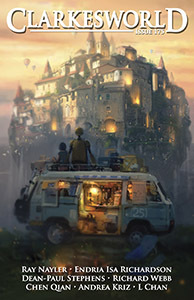
“GUYS! Don’t Lose Hope” by J.C Jongwon Park
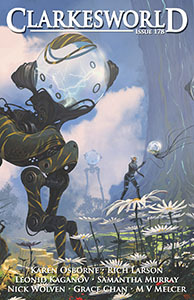
“Garden” by Alejandro Miguel Burdisio
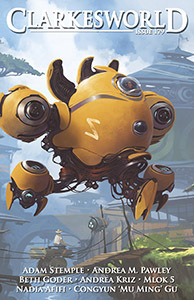
“Little Town” by Alejandro Miguel Burdisio
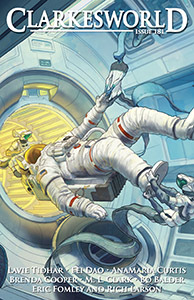
“Mermay 2021” by Alexander “Minze” Thümler
January 12, 2022
Number of Submissions by Author at Clarkesworld in 2021
Today’s dive into the 2021 submission data for Clarkesworld Magazine looks at the volume of submissions from each author in 2021. Returning authors are authors that had submitted at least one story in 2020 or earlier.

The pool of regularly submitting authors is probably smaller than most people expected. An overwhelming majority of authors only submitted a single story in 2021 and nearly 70% of those people were submitting a story to us for the first time. Just under 2000 authors submitted more than one work in all of 2021 and of those half only submitted two. The ratio between US and non-US submissions remains consistent throughout the data. No one submitted more than 40 stories last year (which is the most anyone has done in the last three years). If a number is missing, no one submitted that number of times.
Returning authors represented 38% of all authors and 48% of all submissions. This is in line with previous years. (A surge in first time authors in 2020 led to the returning rate to fall to 36%. That’s the only time it’s gone that low, though actual number of returning authors was consistent.)
Why does this happen? I don’t have that data, but I can make some educated guesses. I know a lot of writers just drop out of the field. Imposter syndrome plus rejection can be a powerful one-two punch. Some discover that it isn’t their passion or that doing it for money ruins it for them. There’s also the possibility that our short rejection times are intimidating to some. And then there’s the occasional spikes in submissions we receive when we’re (unfortunately) featured on a “write for money” website. I imagine that most of those don’t stick around when they realize it isn’t as easy as stringing some words together (or in some cases, cut & pasting). There’s also socio-economic factors that play in for some. Just not enough time to devote to something that won’t help pay the bills.
On a much lesser scale, you have the impact of solicitation of more established authors, loss of writing time when novels enter the picture, and the common desire to be published more broadly (an author may start submitting work to other markets instead of yours in pursuit of that goal). I can’t stress just how small a percentage of the entire pool this is. It’s only impactful if “name” authors are your priority and we choose to treat them like everyone else. We value new authors just as highly. Both are an important part of the short fiction ecosystem.
Anyhow, what we’re seeing is probably some combination of the above and more. (Like the people who complain about not getting feedback.)
Some positives you won’t find in the graph (since it’s focused on submissions, not acceptances):
In 2021, we accepted 8 works submitted by authors on their first try (with us).A bit more than half of all works accepted were by authors we had never published before.and one piece of data I’d like to highlight:
The lifetime average for all authors we accepted works by in 2021 was 7.5 rejections before their first sale to us. This represents a range of 1-62 Clarkesworld submissions before that first sale. (So don’t give up after the 8th!)All the data I’ve been digging through (combined with 15 years of the submissions themselves) has had me thinking about the role of persistence, imposter syndrome, and self-rejection in submissions. Over the years, I’ve started coming around to thinking that in addition to skill, both persistence and (some reasonable level) of imposter syndrome are necessary to get a career off the ground. Imposter syndrome is to be fought when it’s the impetus behind self-rejection, but if we’re listening, it’s also the voice that reminds us we have more to learn. Persistence comes into play making us act on it. Learn more, improve your craft, and keep submitting work. Persistence only becomes troublesome when it veers into stubborness. That’s where you starting making the same mistakes over and over and expect a different result. (This is very common among the angry writers I hear from periodically. There’s typically a lack growth happening in their work from submission to submission.) The only good self-rejection is when it stops you from doing this. (Side note: An observable trajectory of improvement is a unifying thread behind every author we’ve worked with. I can see it in the submissions.)
As much as it would probably swamp us with more submissions, I’d love to see a little more of the right kind of persistence in this data, even if it only means one story every year or two. You decide what pace is healthy or practical. Just keep submitting them here, there, or wherever.
January 11, 2022
Clarkesworld Submissions by Country 2021
Today’s dive into Clarkesworld Magazine submissions data starts with updated versions of some graphs I shared last year. Country data is determined by originating IP address, which can obviously lead to some errors. For example, an American author living in Canada will be listed under Canada and a Chinese author living in China, but using a VPN located in Germany would be listed under Germany. Country names are provided by a third party database we use to process this data.


The results for both of these graphs were more-or-less expected. In 2020, we saw some significant increases in stories from outside the US. Like most data spikes we’ve seen over the years, there’s a momentary decline that lands somewhere between the previous two values. Naturally, we’d like it to keep moving upwards, but understand that this will take time.
At the end of last year, India was within 15 submissions of passing Australia for the #4 slot. We knew it would be a close race, but expected India (which has showed an annual growth trend) to pass them this year. The margin is still very close, 17 submissions in fact.
As the volume of stories from the US is such a significant percentage of those received, removing them allows a better view of what’s happening with the rest of the world:
I dislike having to group 120+ countries into “other” the numbers for many of them are so small that they become practically invisible on the graph. Graphing them together also allows me to demonstrate their collective importance, despite their individual size.
This year, I dug a bit deeper to give you a bit more detail into “other” by showing the top 15 countries by submission.

This is Mexico and Pakistan’s first time in the top 15.
“Other” for 2021 includes the following countries: Afghanistan, Albania, Algeria, Antigua and Barbuda, Argentina, Armenia, Austria, Azerbaijan, Bangladesh, Barbados, Belarus, Belgium, Bermuda, Bolivia, Bosnia and Herzegovina, Brunei Darussalam, Bulgaria, Burkina Faso, Cabo Verde, Cambodia, Cameroon, Chile, China, Colombia, Congo, Costa Rica, Croatia, Cyprus, Czechia, Denmark, Djibouti, Dominican Republic, Ecuador, Egypt, Estonia, Eswatini, Ethiopia, Finland, France, Georgia, Ghana, Greece, Guadeloupe, Guatemala, Hong Kong, Hungary, Iceland, Indonesia, Iran, Iraq, Israel, Jamaica, Japan, Jordan, Kazakhstan, Kenya, Korea (Republic of), Kuwait, Latvia, Lebanon, Liechtenstein, Lithuania, Luxembourg, Malaysia, Maldives, Malta, Mauritania, Mauritius, Montenegro, Morocco, Myanmar, Nepal, North Macedonia, Norway, Oman, Papua New Guinea, Paraguay, Peru, Philippines, Poland, Portugal, Puerto Rico, Romania, Russian Federation, Rwanda, Saint Kitts and Nevis, Saudi Arabia, Senegal, Serbia, Sierra Leone, Singapore, Slovakia, Slovenia, Somalia, Spain, Sri Lanka, Sweden, Switzerland, Taiwan, Tanzania, Thailand, Togo, Trinidad and Tobago, Tunisia, Turkey, Uganda, Ukraine, United Arab Emirates, Venezuela, Viet Nam, Yemen, Zambia, and Zimbabwe.
I’ve created similar graphs for 2020, 2019, and 2018 so you can see how to top 15 have been changing over recent years.



And finally, for the latest installment in why acceptance rates are useless data:
As previously mentioned, our acceptance rate falls around 0.55%. In 2021, it was 0.52% for submissions from the US and 22.22% for submissions from Trinidad. The bad math take on this would be that we greatly favor Trinidad. (For those keeping score: bath math suggests that you submit novella length science fiction from Trinidad for optimal chances at success. Let’s blow you mind and mention that one of the stories we accepted from Trinidad was a science fiction novella.) Meanwhile, back in reality, the truth is that one or two people can dramatically change the results when the sample size is small, like with novellas or stories from Trinidad. Quality and quantity don’t have a stable relationship with one another. There is no secret formula to success.
January 10, 2022
Clarkesworld Submissions by Wordcount
The next series charts focus on wordcount for submissions from 2019, 2020, and 2021 at Clarkesworld Magazine. (We raised our upper wordcount limit on submissions to 22,000 at the start of 2019.) For the purposes of these graphs, wordcount is rounded to the nearest thousand.

The average wordcount for submissions during this window was approximately 4,800, but the most popular length was 2,000 or 3,000 words. Prior to increasing our upper limit, the average length was a steady 4,600. There are clearly more short stories in circulation than novelettes (stories between 7,500-17,499 words) or novellas (stories over 17,500 words).
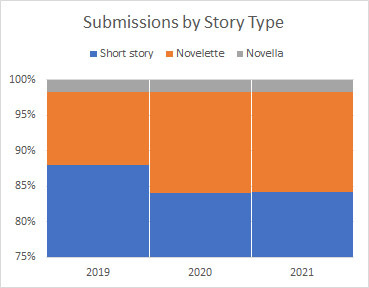
Please note that this graph starts at 75%. The volume of short stories is considerably larger than novelettes and novellas.
Now let’s look at what we accepted in those years:

Going by this you might think we prefer short stories (works under 7500 words), but it’s not a coincidence that, even with annual variation, it nearly mirrors portions of the shape of the submissions graph. We simply have a lot more to choose from.
And this provides me with another way to demonstrate the pointlessness of acceptance rates:

This chart, using a different perspective on the same data, makes it look like we actually favor novellas.
The only reason it looks like a smart move to be writing on the longer end of our wordcount range is that we receive fewer submissions at those lengths. A single acceptance carries considerably more weight than one for an equally strong (or even stronger) story at a shorter, more popular, length. While we would love to see more novelette and novella submissions, it shouldn’t be with the expectation that your odds of publication will be any higher by doing so. In fact, we expect that an increase in submissions at that length would simply flatten that graph.
January 6, 2022
Clarkesworld Submissions Funnel 2017-2021
The following is a representation of submissions to Clarkesworld Magazine broken down by genre since 2017.
Authors: Don’t read too much into this. Acceptance rates are fundamentally misleading. They suppose that all stories are equal in quality and we all know that isn’t true. We also know that the perception of quality is variable and usually evolving. You might even think that a particular genre is favored, but that doesn’t mean your odds are better if you write in that genre. The things that might keep us from accepting a dark fantasy story will also keep us from accepting a similar science fiction story. For example, being predictable or formulaic transcends genre. (No one ever thinks they are doing that, but it happens all the time. Editors read a lot and have emotional distance from your work, so we’re more likely to spot it.)
The outer ring is all submissions.
The middle ring is second round submissions.
The inner ring is acceptances.
All accepted stories came from open submission. We don’t solicit stories.
We stopped considering horror submissions in 2018. After dropping horror, our overall acceptance rate climbed to roughly 0.55%. Over the last five years, the percentage of submissions reaching the second round has dropped significantly and the conversion from second round to acceptance has grown from 8% to nearly 35%. These changes are the likely result of our work with the slush team and how we recruit, monitor, and provide feedback to them.
November 29, 2021
2021 Worldcon Schedule (Discon III)
I’ll be attending Discon III, the 2021 Worldcon in DC (December 15-19). Clarkesworld will have a table in the dealer’s room, but I can also be found on the program at the following events/panels:
Kaffeeklatsch – Neil Clarke
Thu 10:00-10:50 AM, Suite 325
Ask an Editor: Short Fiction Writing
Thu 2:30-3:20 PM, Blue Room
Public Hugo Finalists Reception
Thu 5:00-7:00 PM, Ambassador Ballroom
Signing – Neil Clarke
Fri 11:30 AM -12:20 PM, Autographs 3
The Small Press Takeover of Short Fiction
Fri 4:00-5:00 PM, Forum Room
The Finances of Running a Small Press
Sat 11:30 AM -12:20 PM, Forum Room
Hugo Award Ceremony
Sat 8:00-10:30 PM, Regency Ballroom
October 21, 2021
New publication date for Best Science Fiction of the Year Volume 6
I’m disappointed to announce that The Best Science Fiction of the Year: Volume Six is the latest victim of the industry-wide delays that have been impacting book production since the start of the pandemic. It’s particularly bad at the moment, with paper shortages impacting the schedules at many publishing houses. In this case, our late November publication date has become a late January publication date.
It feels wrong that the volume covering 2020 won’t be available until 2022. I’m also concerned that this will impact sales. We’re going to miss out on the holiday shopping season and it wouldn’t surprise me if the book ended up with a shorter shelf life at brick and mortar stores since volume seven is also scheduled for 2022. (We don’t have a solid date for volume seven, but normally, I’d assume July. We may see that pushed back to give volume six a bit more breathing room. I should know for sure sometime in the next month.) Add to all this that delayed books often end up with canceled or reduced orders from booksellers.
And I’m not alone… This is happening to a lot of books. So what can be done? A few things come to mind: (and these are good for any book, delayed or on-time)
Encourage your local library to put those books on order and check them out when they come in. (If no one checks out the book, that could be a problem for their future ones at that library.)Preorder wherever you normally buy books. Online or at your local bookstore. It doesn’t matter. (And get the book when it comes out, don’t leave them stuck with it, it just gets returned and that’s worse than not having ordered it. Distributors charge fees on returns and the books are often damaged.) Preorders demonstrate that their customers are interested in a title and that in turn discourages bookstores from canceling or reducing orders. It might even get them to order more.When the book does come out, review it. Doesn’t have to be an essay. Just toss it whatever stars you think it deserves at whatever online site you use. At Amazon, for example, a book that gets more reviews gets higher visibility. That helps more than you probably think. Even Tweeting, Instagramming, or Facebooking “hey look what I got” book photos draws in some potential readers.And, of course, the usual tell a friend…October 4, 2021
Best Science Fiction of the Year: Volume 6 Contents and Cover Reveal

Night Shade Books – November 2021
ISBN-10: 1949102521 (hardcover), 194910253X (trade paperback)
ISBN-13: 978-1949102529 (hardcover), 978-1949102536 (trade paperback)
The sixth volume in my year’s best series. This book will feature science fiction short stories/novelettes/novellas originally published in 2020.
Available from:
Amazon.com, Amazon.co.uk, Amazon.ca, Amazon.fr, Amazon.jp, Amazon.com.mx, Amazon.com.br (ebook, trade paperback, hardcover)Barnes & NobleBook Depository (trade paperback)Books-a-Million (ebook, trade paperback, hardcover)Booktopia (trade paperback, hardcover)Indiebound (trade paperback, hardcover)Powells (trade paperback, hardcover)Table of Contents“Scar Tissue by Tobias S. Buckell (Future Tense Fiction, May 30, 2020)“Eyes of the Forest by Ray Nayler (The Magazine of Fantasy & Science Fiction, May/June 2020)“Sinew and Steel and What They Told by Carrie Vaughn (Tor.com, February 26, 2020)“An Important Failure by Rebecca Campbell (Clarkesworld Magazine, August 2020)“The Long Iapetan Night by Julie Novakova (Asimov’s Science Fiction, November/December 2020)“AirBody by Sameem Siddiqui (Clarkesworld Magazine, April 2020)“The Bahrain Underground Bazaar by Nadia Afifi (The Magazine of Fantasy & Science Fiction, November/December 2020)“Lone Puppeteer of a Sleeping City by Arula Ratnakar (Clarkesworld Magazine, September 2020)“Your Boyfriend Experience by James Patrick Kelly (Entanglements: Tomorrow’s Lovers, Families, and Friends, edited by Sheila Williams)“Beyond the Tattered Veil of Stars by Mercurio D. Rivera (Asimov’s Science Fiction, March/April 2020)“The 1st Interspecies Solidarity Fair and Parade by Bogi Takács (Rebuilding Tomorrow, edited by Tsana Dolichva)“Oannes, From The Flood by Adrian Tchaikovsky (Avatars, Inc., edited by Ann VanderMeer)“Yellow and the Perception of Reality by Maureen McHugh (Tor.com, July 22, 2020)“Exile’s End by Carolyn Ives Gilman (Tor.com, August 12, 2020)“Invisible People by Nancy Kress (Entanglements: Tomorrow’s Lovers, Families, and Friends, edited by Sheila Williams)“Red_Bati by Dilman Dila (Dominion: An Anthology of Speculative Fiction from Africa and the African Diaspora, edited by Zelda Knight and Oghenechovwe Donald Ekpeki)“Textbooks in the Attic by S.B. Divya (Rebuilding Tomorrow, edited by Tsana Dolichva)“Seeding the Mountain by M. L. Clark (Analog Science Fiction & Fact, September/October 2020)“Knock Knock Said the Ship by Rati Mehrotra (The Magazine of Fantasy & Science Fiction, July/August 2020)“Still You Linger, Like Soot in the Air by Matthew Kressel (Lightspeed Magazine, August 2020)“Tunnels by Eleanor Arnason (Asimov’s Science Fiction, May/June 2020)“Test 4 Echo by Peter Watts (Made to Order, edited by Jonathan Strahan)“Uma by Ken Liu (Avatars, Inc., edited by Ann VanderMeer)“Beyond These Stars Other Tribulations of Love by Usman T. Malik (Wired, December 11, 2020)“The Translator, at Low Tide by Vajra Chandrasekera (Clarkesworld Magazine, May 2020)“Fairy Tales for Robots by Sofia Samatar (Made to Order, edited by Jonathan Strahan)“This World is Made for Monsters by M. Rickert (The Magazine of Fantasy & Science Fiction, September/October 2020)“Elsewhere by James S. A. Corey (Avatars, Inc., edited by Ann VanderMeer)“Salvage by Andy Dudak (Interzone, January/February 2020)“The Long Tail by Aliette de Bodard (Wired, November 30, 2020)“Rhizome, by Starlight by Fran Wilde (Rebuilding Tomorrow, edited by Tsana Dolichva)“How Quini the Squid Misplaced His Klobučar by Rich Larson (Tor.com, January 15, 2020)Cover art: “FOSS_STATION77” by Pascal Blanché.

